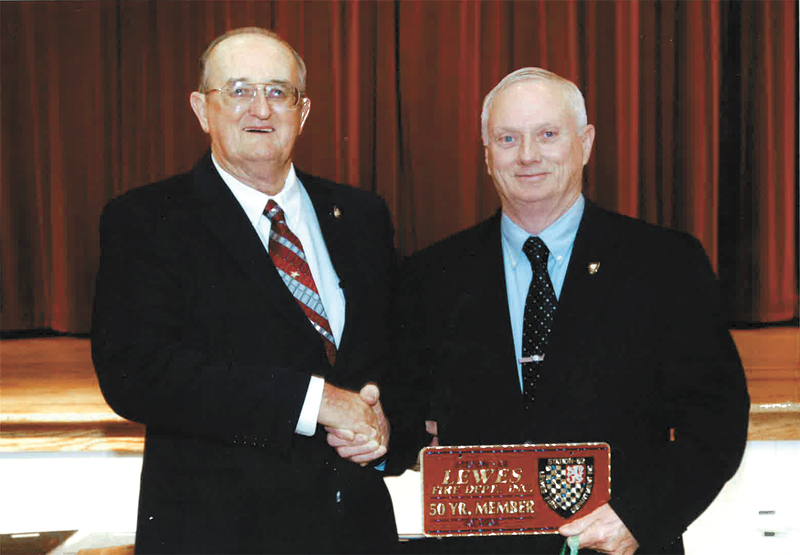Pete Dirks, Phil Fitch: 50 years of service
Many kids say they want to be firefighters when they grow up. Some do, but few are firefighters while they’re still growing up.
Pete Dirks and Phil Fitch were 17 years old when they started slipping into their bunker gear – a heavy protective coat, suspender pants, pull-on boots, and helmets – and climbed aboard a Lewes Fire Department engine to speed off and put out fires.
Both were junior firefighters when put to the test in October 1962, battling the Avenue Theater and Avenue Restaurant blaze in Rehoboth Beach, a fire that still today is locally without comparison.
“That was the first and biggest one I ever went to. I was on the first truck, and they sent us around to Wilmington Avenue to help because the fire was all through the whole theater,” Fitch said.
Dirks and Fitch were among more than 100 firefighters from Lewes, Milton and Rehoboth Beach who fought the conflagration. Fitch said no one was in the buildings, and no firefighters were injured.
“Fire got up in the roof, and it just went. We saved the candy store, but the restaurant went and the theater went,” Fitch said.
G. Edward Wyatt, a Lewes resident, was one of the state fire marshals on the scene who determined an overheated chimney near the ceiling started the fire. Newspaper reports estimated damages at $450,000.
“It was really cold, our lines were freezing in the streets,” Fitch said.
Dirks and Fitch grew up living on Lewes Beach. Both men said they enjoyed small-town life and were among the first three selected to serve as junior firefighters. The third person was Lou Rickards, who was killed in an auto accident in 2002 while driving to a firefighters’ convention.
T.A. Shipley was the firefighter who started and took charge of the junior program, Dirks said.
“I give him credit for everything. He knew we needed it, and it panned out. He told us from day one, the fire company is an awesome organization. Here it is 50 years later, and I’ll tell you the same thing. I totally agree with what he said,” Dirks said.
The men said as junior firefighters they went to fire school for training under the aegis of Delaware Volunteer Firefighters Association.
There they learned to handle water lines, nozzles and ladders, and how to crawl out of a smoke-filled structure. “We didn’t have the breathing equipment like we have today,” Fitch said.
“The way we learned to drive the trucks was after we’d washed it, they’d let us drive it around the building. That’s how we learned to drive,” he said.
Fitch has a collection of newspaper clippings, including ones of the Avenue fire, Nomad Village, Fish Products Co., Gibbs Paint Co. and several other blazes. Clipping photos document firefighting equipment changes over several decades.
“We used our master streams – deluge guns they called them – from the street. Some of them are mounted on the trucks, now,” Fitch observed.
He said neither Lewes nor Rehoboth Beach fire departments owned ladder trucks in the early ‘60s. Rehoboth Beach housed its first ladder truck, equipped with an 85-foot Pirsch-Pitman snorkel, in May 1964. “They still have it,” Fitch said.
Fifty years ago a pump truck could pour 1,000 gallons per minute onto a fire; pump trucks today are capable of streaming more than two times as much, Fitch said.
“I went to one house fire where only two of us showed up. We were standing in the firehouse and the whistle stopped. I could see the fire, the smoke and stuff, and we knew we had a big one.
“We pushed the alarm again, and nobody shows up. I knew how to drive the truck, but I don’t know how to pump it. The other guy told me he knew how to pump, but he didn’t know how to drive. So we took off,” Fitch said.
Lou Fisher, a Lewes police officer joined them at the scene. “He helped us a little bit, and we knocked it down, got it out,” he said.
Fighting fires and losing buildings is unfortunate, but losing lives is tragic.
“We lost two kids in one fire, and lost a little boy in another one not far from the firehouse,” Fitch said.
He said after one senior and three junior firefighters were on the first truck to roll up on the Gibbs Paint Co. fire in Lewes, the department decided to send the younger men to pump school.
“That was all that was left of Gibbs,” Fitch said, showing a newspaper photo of a corner of the building’s one remaining wall.
To become a senior firefighter a person had to be 21, and senior members voted on whether juniors moved up.
In 1963, Fish Products Co. in Lewes, owned by magnate Otis Smith, was set ablaze by a welding torch. Newspaper reports said it took 45 men and eight trucks from Lewes and Rehoboth to put out the fire.
“Lewes and Rehoboth work very well together. Here we are today, and Lewes and Rehoboth have a fire station together on Route 24, and it works, it really does,” Dirks said.
Dirks and Fitch joined the U.S. Army in 1965. Both were stationed at Fort Knox, Ky., for basic training. Fitch was later assigned to Fort Miles near Lewes, where he worked in general supply.
“I’m glad I joined- it made me a better person,” he said.
Dirks transferred to Fort Bliss, Texas, where he trained to operate the M42 Duster tank.
Today, Dirks, 68, is a Sussex County constable, and Fitch, 67, is a building contractor.
The best part of being a firefighter, the men said, is the friendships that are formed and seeing things get done.
“Being a member is something to be proud of. It took a pretty good commitment,” Fitch said.
“My main thing is service for others,” Dirks said.






















































